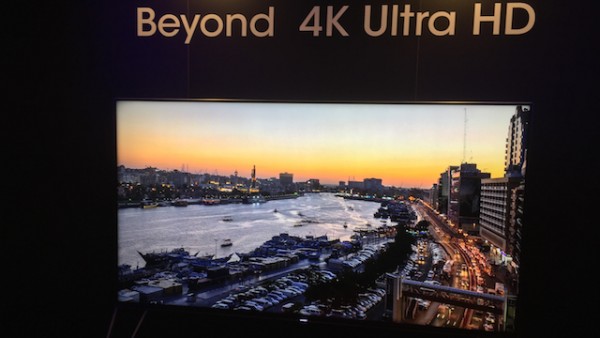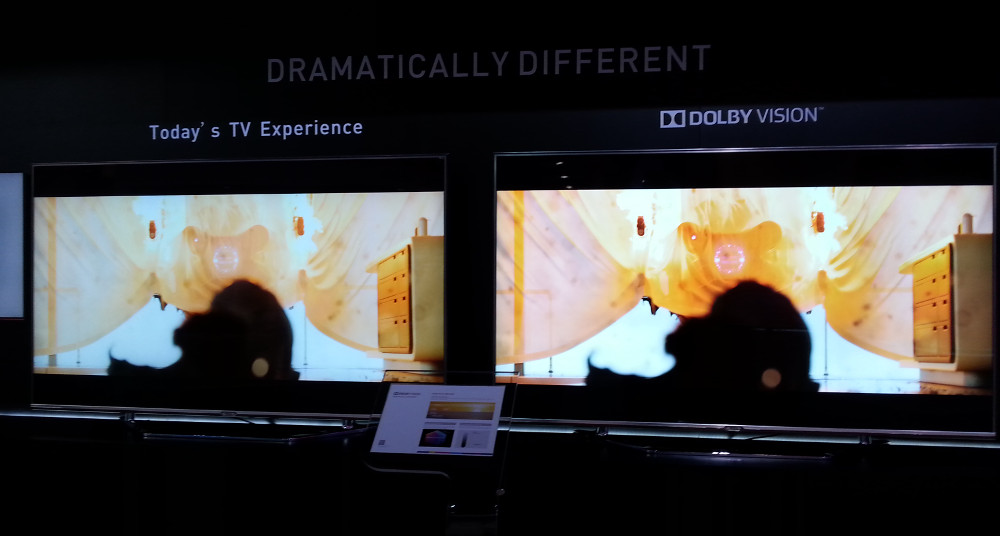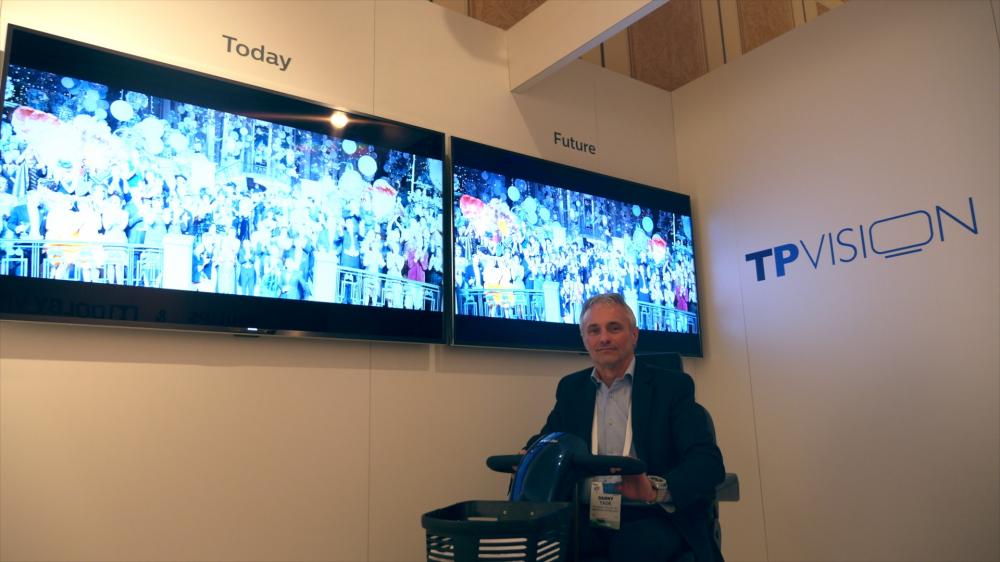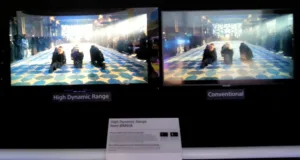Netflix reaffirmed an earlier announcement that it would be adding support for High Dynamic Range (HDR) to its 4K content later this year. It is apparently partnered with LG and Sony to deliver this option.
Warner Brothers will release three movies in Dolby Vision HDR in 2015: The Lego Movie, Edge of Tomorrow and Into the Storm. But TVs will need to have the Dolby Vision HDR decoder and processor built-in to see them in HDR.
Sharp plans to offer HDR TV models in the second half of 2015, although was not very specific about sizes. Sharp has shown Dolby Vision demos in the past, but there was no such branding on the current sets so it is unclear if it will include Dolby Vision or a home grown version of HDR.
On display was a 65” UHD panel with pixel-splitting. This is the new name for the sub-pixel rendering used on Quattron Plus TVs). Pixel splitting on a UHD-resolution TV is supposed to give resolution that is closer to that of the 8K panel, which it apparently does. However, the UHD+pixel-splitting panel also had HDR technology while the 85” native 8K panel right next to it, did not. The difference was apparent with the HDR panel actually looking better than the native 8K panel.
 Sharp’s Pixel Splitting Technology allows images that are “Beyond UHD” with HDR
Sharp’s Pixel Splitting Technology allows images that are “Beyond UHD” with HDR
HDR is likely to be coupled with wide color gamut, which will probably include models that use phosphor-enhanced LEDs and models that use quantum dots (a 70” UHD model is coming in 2015).
Sony showed its version of HDR in the booth as well. The top of the line 75” X940C UHD-4K model was showing Sony’s own version of HDR in a comparison to a standard TV. This is the only model that is sure to have HDR – the booth representative was unsure if the 65″ and 85″ HDR models from 2014 would be carried over to 2015.
Sony’s X-tended Dynamic Range Comparison at CES 2015
TCL showed an 85” HDR model based upon Dolby Vision technology. It is now commercially available, but only in limited quantities and in China and SE Asia only.
 TCL HDR Comparison at CES 2015 A Philips HDR TV using Dolby Vision technology was shown in the Dolby Suite (see Dolby HDR Updates from CES 2015) as well as the TP Vision booth. In the TP Vision demo, a Philips TV with rec 709 color space and 450 nits of peak luminance was shown next to the Dolby Vision enhanced set that achieved the DCI-P3 color space and 700 nits of peak luminance. The standard set ran content mastered at a peak luminance of 100 nits while the Dolby Vision model ran the same content but mastered at a peak luminance of 1000 nits. The Dolby Vision IC is supposed to map the mastered content to the capabilities of the TV – scaling up in luminance on the standard TV and down on the Dolby Vision one – along with changing the color saturation as well.
TCL HDR Comparison at CES 2015 A Philips HDR TV using Dolby Vision technology was shown in the Dolby Suite (see Dolby HDR Updates from CES 2015) as well as the TP Vision booth. In the TP Vision demo, a Philips TV with rec 709 color space and 450 nits of peak luminance was shown next to the Dolby Vision enhanced set that achieved the DCI-P3 color space and 700 nits of peak luminance. The standard set ran content mastered at a peak luminance of 100 nits while the Dolby Vision model ran the same content but mastered at a peak luminance of 1000 nits. The Dolby Vision IC is supposed to map the mastered content to the capabilities of the TV – scaling up in luminance on the standard TV and down on the Dolby Vision one – along with changing the color saturation as well.
The Dolby Vision TV uses a new direct backlight technology that likely replaces the white LEDs with an array of blue LED coupled with a quantum dot film. This will increase brightnes while also lowering power consumption and increasing the color gamut. See
 Philips TPVision HDR comparison at CES 2015 Philips also showed a home grown version in a separate suite (see Philips Explains its HDR Solutions). Philips says it has not decided if it will bring the Dolby Vision TV or its home grown version to market or not.
Philips TPVision HDR comparison at CES 2015 Philips also showed a home grown version in a separate suite (see Philips Explains its HDR Solutions). Philips says it has not decided if it will bring the Dolby Vision TV or its home grown version to market or not.
Samsung is incorporating HDR into its SUHD TV. apparently in combination with other picture enhancements such as wider color gamut. According to the company, 3 models are planned for 2015, probably at 65″, 78″ and 88″ in the top-of-the-line JS9500 series. These have local area dimming from a direct backlight and about 1000 nits of peak luminance making them ready to show HDR content, as well as including quantum dot technology. A new set was used to show some HDR content in a private room, apparently, although it is unclear if this was a Dolby partnership or Samsung’s own HDR implementation (most likely the latter).
Panasonic had a dark room demo where it showed a number of picture enhancements. One was an HDR demo implemented on a 65″ LCD panel that has 128 local dimming zones. Peak luminance is 1000 nits but the company uses a red phosphor LED solution so the color gamut is 98% of DCI-P3 – still well short of 2020. Panasonic plans to introduce HDR in 2015 but specifics on models and timing were not available. Panasonic is not working with Dolby and is calling its flavor of HDR “Dynamic Range Remaster”.
Hisense showed wide color gamut TVs at CES and said it also included high dynamic range. Hisense is said to be a Dolby Vision partner but there was no mention of Dolby Vision that I saw.
Another Dolby Vision partner, Toshiba, was at CES but again, I saw no mention of HDR. In fact, there were no new TVs (Toshiba is Re-Assessing its US TV Plans)
Vizio was not on the show floor CES, as usual, but we were told prior to CES that the company still plans to bring Dolby Vision HDR TVs to market, but the timing is now planned ast the first half of 2015 for the Reference series.

